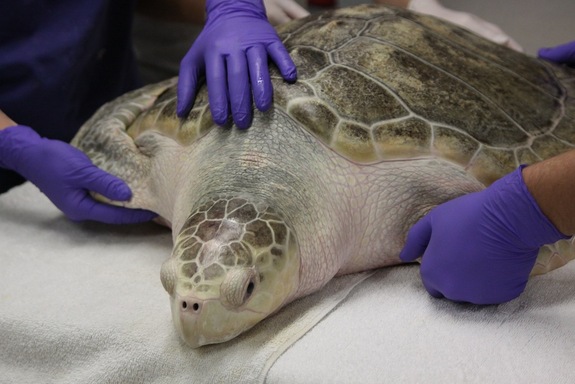Endangered Sea Turtles Feed in Potentially Hazardous Parts of Gulf of Mexico

The endangered Kemp's ridley sea turtle has been found feeding in the Gulf of Mexico, in waters threatened by oil spills, heavy commercial fishing and oxygen depletion.
The Kemp's ridley turtle is the most endangered and smallest hard-shelled sea turtle in the world. A new study released jointly by the U.S. National Park Service and the U.S. Geological Survey uncovered some details about the turtles' foraging and migration patterns, in an effort to learn more about the species and better conserve it.
Little is known about why the turtles feed in certain areas and how human activities may be affecting the animals' health or behavior. To find out more, researchers analyzed 13 years' worth of satellite tracking data from turtles tagged at nesting sites between 1998 and 2011. The turtles at the two main nesting sites were found feeding at areas off the U.S. Gulf Coast, including near Louisiana and Mississippi.
"Protecting feeding grounds for adult female sea turtles is important for the recovery of the species, and this new information is important for future planning and restoration decisions," Donna Shaver, chief of the National Park Service's Sea Turtle Science and Recovery division at Padre Island National Seashore, said in a statement.
The researchers tagged dozens of adult female sea turtles nesting on the beach at Padre Island National Seashore, located off the coast of Texas. Using satellite telemetry — a method of measuring and transmitting data from remote areas — as well as statistical techniques, the scientists determined where and when the turtles foraged.
Previous studies tracked the Kemp's ridley from nesting sites along the Gulf Coast up to northern Texas and Louisiana, and sometimes to sites as distant as peninsular Florida. But scientists couldn't tell whether the turtles were foraging or migrating at each location.
The research team also tagged turtles at nesting sites 200 miles (320 kilometers) south of Padre Island, in Rancho Nuevo, Mexico. It was the first time they tracked turtles to this part of the Gulf, Shaver said.
Get the world’s most fascinating discoveries delivered straight to your inbox.
The findings were published online Tuesday (May 28) in the journal Ecology and Evolution.
Joint efforts by Mexico and several U.S. agencies have boosted populations of this endangered species. The efforts include protecting nesting turtles and their nest sites, and regulating fishing. As a result, the number of Kemp’s ridley nest sites in the Gulf region has grown from 702 nests in 1985 to about 22,000 in 2012.
Adult Kemp's ridley sea turtles measure about 2 feet long (0.6 meters) and weigh up to 100 lbs. (45 kilograms). Found in the Gulf of Mexico and the Atlantic seaboard, the species feeds mainly on shallow water crabs. The turtle takes its name from fisherman Richard Kemp of Key West, Fla., who gave scientists the first specimen of the species back in 1880.
Follow Tanya Lewis on Twitter and Google+. Follow us @livescience, Facebook & Google+. Original article on Live Science.


